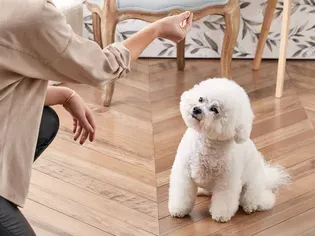How to Train Your Dog to Sit on Command
Updated on 05/26/24

Mastering the Art of Canine Obedience: A Comprehensive Guide to Training Your Dog to Sit on Command
Obedience training is a cornerstone of responsible dog ownership, fostering a harmonious bond between you and your beloved furry friend. Among the essential commands, "Sit" holds a special significance, as it lays the foundation for more advanced training and ensures your dog's safety and well-being.
This comprehensive guide will empower you with the knowledge and techniques to effectively train your dog to sit on command. We'll delve into the intricacies of positive reinforcement, lure-reward training, and shaping, providing you with a step-by-step roadmap to success.
The Science Behind Positive Reinforcement
Positive reinforcement is the cornerstone of effective dog training. When you reward your dog for desired behaviors, you reinforce those actions, making them more likely to occur in the future. This approach fosters a positive relationship between you and your dog, building trust and enhancing the training experience.
Step-by-Step Guide to Sit Training
1. Introduce the "Sit" Cue: Begin by holding a treat close to your dog's nose and gently move it over their head towards their tailbone. As they naturally follow the treat, their hindquarters will lower, prompting them to sit. Simultaneously, say the cue "Sit" in a clear, consistent voice.
2. Reward and Repeat: Upon their successful sit, immediately reward your dog with the treat while simultaneously praising them enthusiastically. Repeat this process multiple times, ensuring your dog understands the association between the cue "Sit" and the desired behavior.
3. Fade the Lure: As your dog grasps the concept of sitting on command, gradually reduce the use of the lure. Start by moving the treat closer to their nose, then simply present your hand as the cue. Eventually, you can phase out the lure entirely, relying solely on the "Sit" cue.
4. Introduce Distractions: Once your dog reliably sits on cue in a controlled environment, introduce distractions to test their obedience. Start with minor distractions, such as toys or other people, and gradually increase the level of difficulty. Reward your dog for maintaining focus and sitting on command despite distractions.
5. Practice Regularly: Consistency is key in dog training. Regular practice reinforces the desired behavior and builds muscle memory. Set aside dedicated training sessions each day, and integrate practice into everyday interactions, such as when asking your dog to sit before entering a door or feeding them.
Troubleshooting Common Issues
1. My dog is not following the lure: Patience and persistence are crucial. Ensure the treat is high-value and adjust the distance and movement of the lure to suit your dog's abilities.
2. My dog sits but then stands up immediately: Break down the training into smaller steps. Begin by practicing sit for short durations and gradually increase the duration as your dog becomes more proficient.
3. My dog is resisting the training: Assess your dog's body language for signs of stress or discomfort. Ensure the training environment is positive and free from distractions. Consider seeking professional guidance if the resistance persists.
Benefits of Sit Training
* Control and Safety: Teaching your dog to sit on command provides greater control in various situations, such as preventing them from jumping on guests or running into the street.
* Communication and Bonding: Sit training enhances communication and strengthens the bond between you and your dog. It demonstrates that you are in charge while fostering mutual respect.
* Advanced Training: Sit is a foundational command that opens doors to more advanced training, such as stay, come, and heel.
Conclusion
Training your dog to sit on command is a rewarding and empowering experience that strengthens the bond between you and your furry companion. By embracing positive reinforcement, lure-reward training, and shaping, you can effectively teach your dog this essential obedience command. Remember to be patient, consistent, and enthusiastic throughout the training process. With dedication and love, your dog will master the art of sitting on command, enriching your lives with increased control, communication, and a deep sense of accomplishment.
Explore More Pets

Basic Training
Puppy and Baby Introductions

Working Dog Breeds
All About Search and Rescue Dogs

Dog Treatments
Puppy Vaginitis: Signs, Causes and Treatment

Dog Adoption
After More Than 1,200 Days in the Shelter, Coco Goes Home

Basic Training
How to Train Your Puppy to Go on Potty Pads

Hybrid Dog Breeds
The Difference Between a Mutt, Mixed Breed, or Designer Dog?

Dog Treatments
Nail Problems in Dogs

Puppies
7 Reasons Why Two Dogs Are Better Than One
